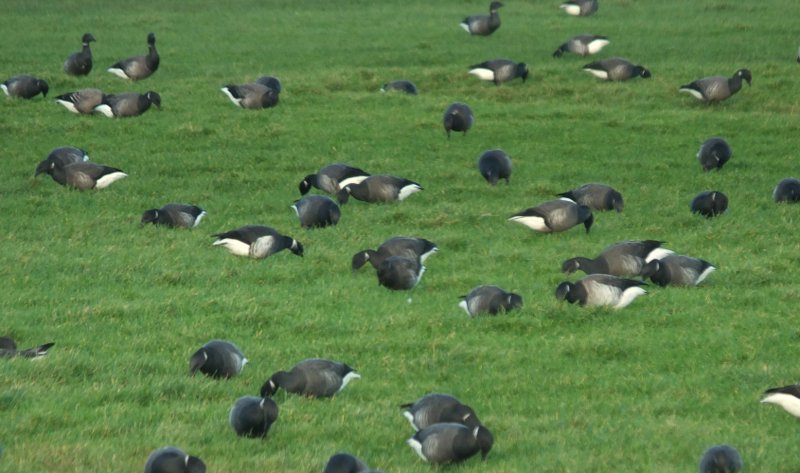| Vorige | Terug | Volgende |

| Naam: | Zwarte Rotgans / Branta nigricans |
| Plaats: | Stroe |
| Datum: | 13 december 2015 |
| Fotograaf: | |
| Toegevoegd: | 14 december 2015 |
| Determinatie: | Zeker |
| Hits: | 5636 |
 |
| Voor de puzzelaars onder ons; er staat ook een Witbuikrotgans op. |
 |
| en zoals al eerder opgemerkt nigricans omzetten naar orientalis ook inmiddels volgens HBW http://www.hbw.com/specie... |
 |
| Apologies for posting in English. In the HBW link, I see the statements "boundaries between forms produce numerous intergrades and hybrids." and "170,000 B. b. bernicla wintering in W Europe". My question would be, how many intergrades (as opposed to hybrids) between bernicla and any other taxa do we see in Europe? Many? |
 |
| @Richard,Max. Apologies for the language problems on this site. Don't know why Max refers to HBW for taxonomy. Perhaps he is confused: DB follows CSNA in treating brent geese as three species, not four subspecies, and nigricans is an older name than orientalis. I guess intergrades would come from clines in subspecies, called hybrid zones in species. Personally, I have no experience with such a hybrid population here, just the occasional hybrid pair (a few nigricans x bernicla). Do you see any evidence of intergrades in the UK? |
 |
| Okay, so nigricans is the only form/species of Brant with a subspecies (orientalis and nigricans) according to the CSNA, this seens a bit unlogical, not? |
| Gewijzigd op: 2015-12-16 06:38:53 |
 |
| @Max: Yes, two subspecies of Black Brant are/were sometimes recognized, with B n nigricans wintering in western America and B n orientalis in eastern Asia (eg, http://avibase.bsc-eoc.or...). Following this arrangement, most Black Brants arriving with nearctic B hrota in the UK should B n nigricans; the ones in the Netherlands arriving with B bernicla should be B n orientalis. However, the distinction between the two populations is usually not made (cf Howard & Moore 2013). |
 |
| @Max: You are right about 4 brent species and not 3 but for the time being Gray-bellied Brant (Melville Island etc) is mentioned under ‘unnamed taxa’ in the introduction of Dutch Birding's WP species list, as no formal (sub)species description has been made. Of course, three years ago, Birdingfrontiers and Cornell (ie, Birds of North America Online BNA) came with the news that the type specimen of Black Brant Branta nigricans was in a fact a Gray-bellied. If confirmed, it means that the name B nigricans can be used for Gray-bellied Brant, while B orientalis indeed becomes available for Black Brant. I have just checked BNA though and I can not find a mention of any of this. Perhaps I miss something? Can you see whether HBW refers to a paper confirming the identity of the type specimen? It will help CSNA to make a decision whether it is indeed correct to change the scientific name of Black Brant. |
 |
| PS: Gerald confirmed that, in BNA, Black Brant is still named Branta nigricans, not B orientalis (see http://bna.birds.cornell.... ). George reminded me that the type specimen of nigricans originated from the range of Gray-bellied Brant but also that there was no genetic research confirming it to be a Gray-bellied and not an out-of-range Black. So, the conclusion put forward by birdforum http://www.birdforum.net/... and HBW may be premature. |
 |
| and Reeber, thanks though. |
 |
| Hoezo ingewikkeld!!!! |
 |
| In answer, no ... only the occasional hybrids that we all know about. In terms of the 'edge ranges' of bernicla, I think it is fair to say there is effectively zero intergradation with either hrota or nigricans; we see virtually the whole population of bernicla in Europe (and the high arctic hrota here, plus low arctic hrota in e.USA) and evidence for "numerous intergrades" is completely lacking. Thus it is my worry HBW that is ill-informed in its statement. Of course, I could not comment with authority re. the situation in nw.Canada/Pacific when it comes to the hrota/gray-bellied/nigricans populations. |
 |
| @Richard: agreed! Combined with your id paper in Birding World 10: 11-15, 1997, and Shields' analysis of mtDNA (Auk 107: 620-623, 1990), this was 20 years ago a reason for CSNA to treat these forms as species (see Dutch Birding 19: 22, 1997). It is one of a couple of CSNA decisions not (yet) copied by other 'authorities'... |
 |
| Leuk/interessant om even te delen denk ik.. Al jaren volg ik een paartje Hybride Witbuik x Zwartbuikrotgans, beide vogels zijn dus al hybride en dat maakt dit een uniek paartje. Dat juist deze vogels (waarvan de gent is geringd destijds door Gerard Muskens) met elkaar gepaard zijn geeft mij het gevoel dat broer en zus ooit met elkaar in zee zijn gegaan. Het zou anders wel heel erg sterk zijn dat juist twee dezelfde (best schaarse) hybriden elkaar weten te vinden... In ieder geval zijn de laatste jaren altijd goed voor een jong of drie/vier. Via deze link; http://waarneming.nl/soor... kan je flink wat platen vinden van dit paartje. Het unieke van dit jaar is echter dat ze 1 jong van vorig jaar niet van zich hebben kunnen afschudden en volledig tolereren. Geweldig natuurlijk want dan kan ik eens zien hoe die jongen er als adult uit zullen zien! Op foto 2 en drie staat hij/zij hier zo'n beetje in het midden; http://waarneming.nl/waar... En hier nog even een zuiver paartje met jongen ter vergelijking; http://waarneming.nl/foto... Als je dan birdingfrontiers bekijkt; http://birdingfrontiers.c... komt dat akelig overeen, iets teveel zeg maar... Kortom zolang er van dit soort spul rondloopt in NL en Grey Billied niet geringd gaat worden in de toekomst zal er m.i. nooit een aanvaard exemplaar gaan komen...! |






